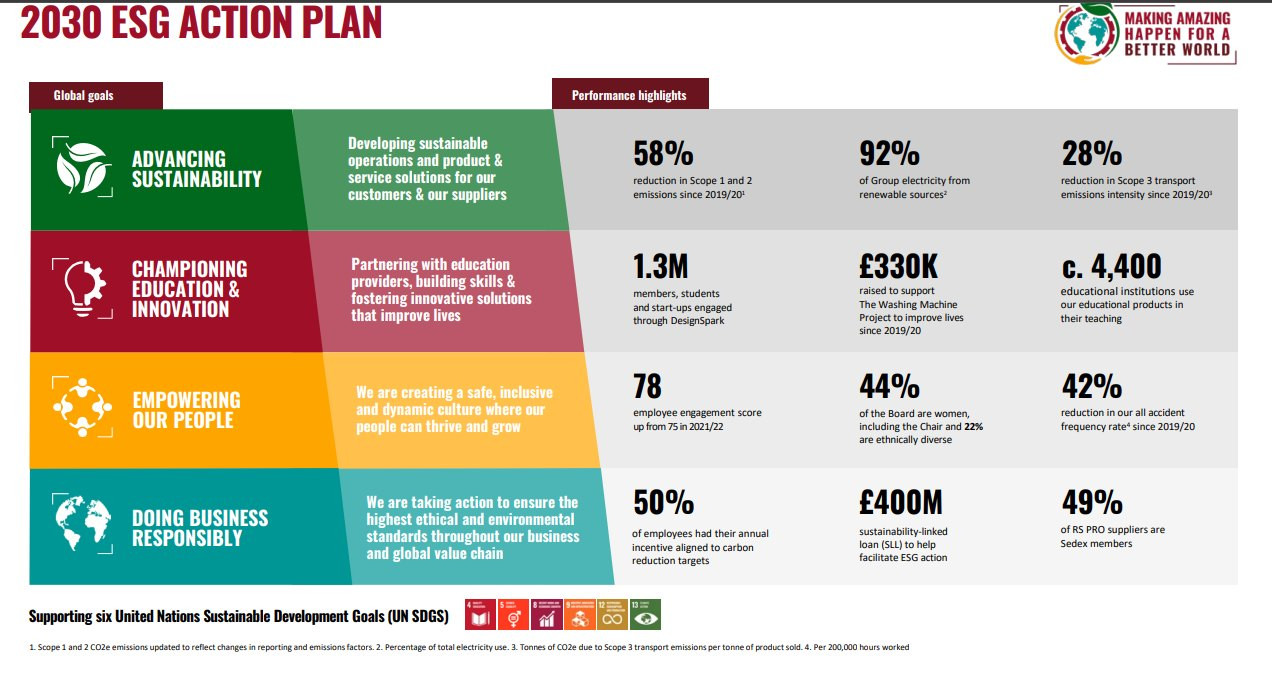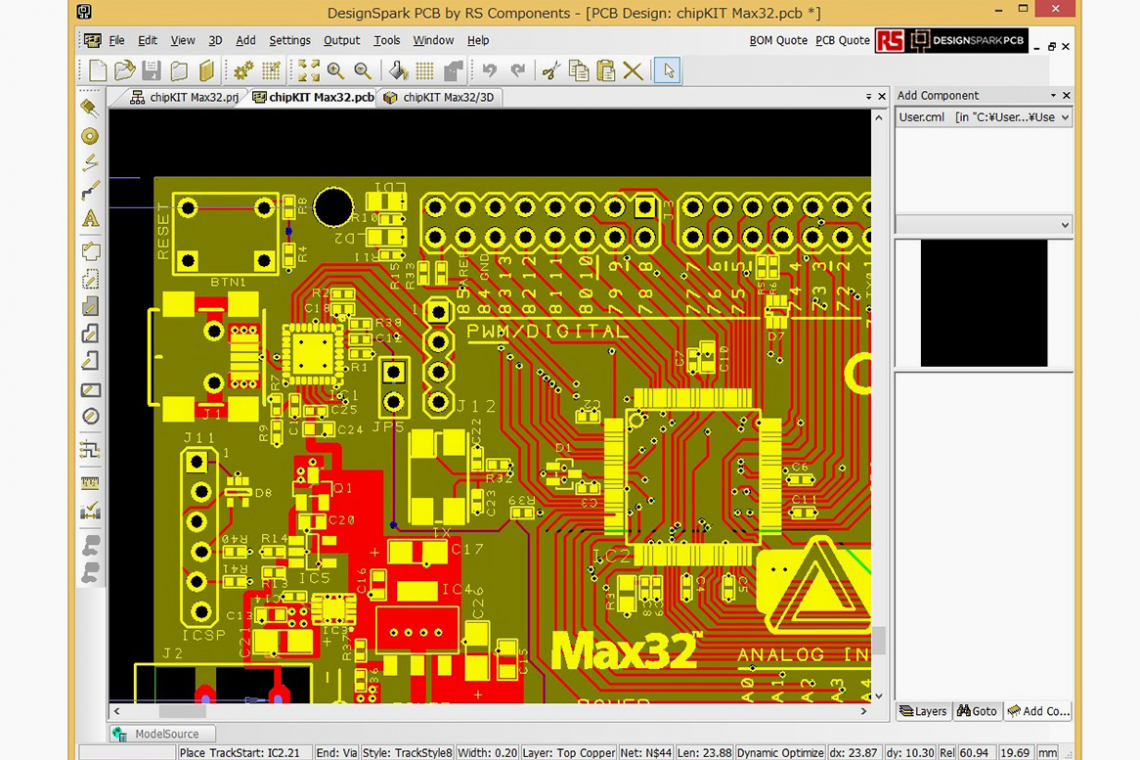DesignSpark PCB is an interesting example of how EDA software is becoming a globally used tool for electronics design. This article shows that the creators of the tools belonging to DesignSpark are in the process of further optimizing both the tools and their usability. At the same time, the RS Group is making great strides towards greater sustainability within the company itself, with implications for the entire electronics industry.
DesignSpark PCB was presented to the public in July 2010. The software is based on a tool from the company Easy-PC and was the result of cooperation between the electronics distributor RS Components and the software developer Number One Systems. DesignSpark PCB was advertised at the time as a fully functional tool for PCB design that was available to all interested parties free of charge and without restrictions [1]. It was the first tool of its kind from RS in the design sector. However, only members of the new online portal DesignSpark, which was founded at the same time, were to be able to use it free of charge. Today, it is referred to as the DesignSpark online community. The online portal provides information, references to resources and evaluations and is also the exchange forum for users of this and other tools [2]. It has become increasingly popular over the years as free access for members to a range of design tools hosted in the Spark Store has expanded. This made RS the market leader in free PCB design software in the years following its founding.
A key reason for this is most likely the increased capabilities of DesignSpark PCB over time, which is now a complete design ecosystem. The powerful software engine, which can be used to capture schematics and design PCBs and layouts, has a range of functions and features that go beyond the usual level of free PCB design software(Fig. 1).
Among other things, users have access to a full suite of video tutorials, many design examples and an extensive parts library. You can create schematics targeting PCBs up to 1 x 1 m in size with any number of layers, pads and nodes. Designs created using other PCB design software can also be imported. These include PADS, OrCAD, Altium and CADSTAR. Fully (automatically) routed and design rule checked designs can then be exported to a range of file formats including IDF, DXF and standard Gerber/manufacturing formats. This allows designers to progress more quickly through the design and production preparation process.
Tool trio from 2015
 Fig. 2: Engineering platform DesignSpark 2023TheDesignSpark PCB tool was followed in 2013 by 'DesignSpark Mechanical', a free 3D modeling software for solid models with STL export. It originated from the collaboration between RS and SpaceClaim Engineer. In 2015, the 'DesignSpark Electrical' tool for electrical installations was added, resulting from the collaboration between RS and SolidWorks Electrica. The three DesignSpark programs work together to some extent. All tools became part of the DesignSpark engineering platform and the DesignSpark online community(Fig. 2). The software developers at RS also work with leading CAD providers around the world to provide users with additional useful tools. One example of this is Dassault Systèmes' DraftSight, a professional 2D drafting and 3D design solution. As a result of RS's continuous work, the user platform reached one million members for the first time in January 2021 and 1.3 million by January 2023, according to [3]. Producers, developers, technicians and engineers use it to share their ideas. Unfortunately, the support language is only English and support is only provided online. A team of developers and programmers regularly maintain the tools so that updates are made annually. In 2020, for example, version 10 was released for the 10th anniversary, which is already available in Windows 11. The RS software is even offered for use by users in Russia [4].
Fig. 2: Engineering platform DesignSpark 2023TheDesignSpark PCB tool was followed in 2013 by 'DesignSpark Mechanical', a free 3D modeling software for solid models with STL export. It originated from the collaboration between RS and SpaceClaim Engineer. In 2015, the 'DesignSpark Electrical' tool for electrical installations was added, resulting from the collaboration between RS and SolidWorks Electrica. The three DesignSpark programs work together to some extent. All tools became part of the DesignSpark engineering platform and the DesignSpark online community(Fig. 2). The software developers at RS also work with leading CAD providers around the world to provide users with additional useful tools. One example of this is Dassault Systèmes' DraftSight, a professional 2D drafting and 3D design solution. As a result of RS's continuous work, the user platform reached one million members for the first time in January 2021 and 1.3 million by January 2023, according to [3]. Producers, developers, technicians and engineers use it to share their ideas. Unfortunately, the support language is only English and support is only provided online. A team of developers and programmers regularly maintain the tools so that updates are made annually. In 2020, for example, version 10 was released for the 10th anniversary, which is already available in Windows 11. The RS software is even offered for use by users in Russia [4].
Further development at all levels
For RS as a group of companies, the continued rapid growth of the DesignSpark online community is very important because it plays a key role in promoting sales within the Group. The following information should make this easier to understand. RS Components, which is actually a brand of RS Group plc (formerly Electrocomponents plc), is a global omni-channel provider of product and service solutions for developers, designers, manufacturers and maintenance staff in industrial companies(Fig. 3). It has around 8,700 employees and offers more than 700,000 industrial and electronic products from over 2,500 leading suppliers. According to its own figures, it supplied over 1.1 million industrial customers in 2022/23. This and the large number of branches in 31 countries ensure a broad reach. The components ordered by members of the DesignSpark online community, for example, make a significant contribution to sales growth.
 Fig. 3: Since 2017, the RS Group headquarters have been located in London's Two Pancras SquareInterestingis the breakdown of turnover in 2022/23 by products and service solutions:
Fig. 3: Since 2017, the RS Group headquarters have been located in London's Two Pancras SquareInterestingis the breakdown of turnover in 2022/23 by products and service solutions:
- Automation and I&C 39%
- Mechanics and fluid technology 5%
- Electronics 23 %
- Maintenance/servicing 24
- Safety and protection technology 4 %
- Single-board computers 1 %
- Other 4 %
In the 2022/2023 financial year, which ended on March 31, 2023, the Group had an annual turnover of 2,982 million pounds sterling according to the ESG Report (Environmental, Social and Governance Report) [5]. This is broken down by geographic region as follows
EMEA - 59%, Americas - 32%, Asia Pacific - 9%. This clearly shows that Europe accounts for a significant share of sales. The very important ESG report will be discussed later. RS Group plc comprises nine brands: RS Components, Allied Electronics & Automation, RS PRO, OKdo, DesignSpark, IESA, Synovos, Needlers and Liscombe.
A feature of the RS Group's current activities is to extend its reach at different levels, starting at the DesignSpark level and ending with the Group as a whole. This is demonstrated below.
RS optimizes the use of DesignSpark
In January 2023, the RS Group announced that it was launching a new phase of work with a new sales concept [6]. The next phase now presented for the DesignSpark engineering community is all about providing members with an even more improved and increasingly personalized offering. However, free use will then only be partially possible. In the future, DesignSpark will have three subscription levels:
- DesignSpark Explorer
- DesignSpark Creator
- DesignSpark Engineer.
These will allow members to determine the scope of design tools and resources they use according to their requirements. RS, for its part, takes into account the fact that the ever-increasing complexity of electronics also means that the cost of providing features is constantly rising, meaning that the cost-benefit ratio for the providing company must be more favorable.
DesignSpark Explorer is primarily aimed at students, makers and developers. This level allows members the usual community access and the opportunity to use the tools and design resources free of charge. As always, users are given all the options they need to make a quick leap from concept to prototype. The most important tools available at this level include
- DesignSpark PCB, including the component libraries and other tools for creating error-free PCBs
- DesignSpark Mechanical, the direct modeling program using 3D CAD software and particularly suitable for prototyping.
Users have access to more than 100 million 3D models and 2D symbols for circuit design. The ability to search within a billion components and access datasheets and lifecycle status information is also retained.
DesignSpark Creator is intended for users who are looking for even more advanced tools and resources and have more sophisticated requirements. Additional DesignSpark options are now available that provide access to design tools with advanced features. However, at a price of €11.49 per month, this service is no longer free. RS is targeting professional manufacturers and SMEs. The offer includes the same tools and resources as the Explorer level, but with the addition of an extended version of DesignSpark Mechanical. It features a 3D mirroring tool and tools for labeling parts and creating production drawings. Extended parts libraries, which provide further information on the components, are also included. In addition, there will be skills and learning videos, tutorials and tips from experts in the DesignSpark community.
DesignSpark Engineer offers even more power, but at the equally moderate price of €16.99 per month. This tier is designed to provide the ultimate level of creativity and flexibility for the most demanding users. This makes it ideal for professional design engineers. DesignSpark Engineer offers the same enhanced features of DesignSpark Mechanical that are available in DesignSpark Creator. In addition, DesignSpark PCB is even more powerful in this case. It enables the use of blind and buried vias for high-density PCB design, custom pad shapes, differential pair routing for high-speed signals, a panel editor and much more. In addition to the extensive support available in the Creator level, DesignSpark Engineer provides even more information on components, including export compliance data and PCN/EOL notifications as well as help with component alternatives. It is therefore intended for the professional designer of high-tech HDI PCBs, i.e. for advanced designs.
As always, users have all the tools they need to quickly jump from concept to prototype
RS estimates the real value of this complete feature set for subscribers at well over €1000. Through the subscription model, the company is now able to offer these capabilities at a price equivalent to the monthly cost of a Netflix subscription, for example.
As part of the launch, RS invited people to take part in the free trial period, which lasted until March 31, 2023. It was intended to allow all DesignSpark members to try out the 'Creator' and 'Engineer' subscription options and the advanced versions of the DesignSpark tools provided here. Commenting on the changes, RS management said that collaboration with the DesignSpark community and extensive research into members' needs had shown that there is no one offering that suits all users equally, but that more differentiation is needed. Detailed information on the three subscription levels and their content can be found in clear tabular form at [7]. In addition to the DesignSpark software team, the DesignSpark engineering online community is also working to continuously improve the DesignSpark tools.
More environmental protection
The activities to improve the range of services and the use of DesignSpark are synchronized with the determined ESG strategy (Environmental, Social and Governance Strategy) of the RS group of companies. If you take a closer look at the two directions, it becomes clear that they are not only closely linked, but also interlinked. They are mutually dependent from a progress perspective. The ESG Strategy was published in November 2021 as the ESG Action Plan 2030 entitled "For a Better World" [8]. The plan contains four global goals and 15 ambitious actions for 2030. The approach also supports six of the UN Sustainable Development Goals and lays the foundation for the company's long-term vision until 2050. The core of the plan is the development of sustainable operations and product and service solutions to reduce environmental impact and combat climate change. RS is committed to achieving net-zero greenhouse gas emissions in its global operations by 2030 and across the entire value chain by 2050. This also involves more environmentally friendly green distribution models.
The four global goals of the ESG strategy are shown in Figure 4. They reflect a complex approach from a technical, educational, social and ethical perspective, and the following are examples of targets to be achieved in the reporting period 2029/30 compared to 2019/20 in the area of "Promoting sustainability":
- Develop sustainable operations, product and service solutions to reduce environmental impact and combat climate change
- Net zero CO2 with the science-based goal of reducing absolute emissions from own operations by 75%
- More sustainable packaging by reducing intensity by 30%, with 100% of packaging being largely reusable, recyclable or compostable and 50% made from recycled material.
Working with suppliers and customers to achieve a global net zero value chain by 2050:
- Engage 65% of suppliers as part of the ESG project to set science-based targets to increase sustainability by 2025
- Reduce transportation emissions by 25% per ton sold
- Develop innovative and sustainable product and service solutions for all customers.
 Fig. 4: The four global goals of the RS Group's ESG strategy with the progress achieved in 2022/23 (right-hand side of image)Building skills and promoting innovative solutions that improve lives: Collaborate with 1.5 million engineers and innovators to develop socially responsible and sustainable solutions.
Fig. 4: The four global goals of the RS Group's ESG strategy with the progress achieved in 2022/23 (right-hand side of image)Building skills and promoting innovative solutions that improve lives: Collaborate with 1.5 million engineers and innovators to develop socially responsible and sustainable solutions.
Of course, this goal primarily concerns the designers and producers of electronics. This is where the key role of large distribution companies in the transformation process towards greener electronics and therefore a better environment becomes clear. Electronics designers and producers are given the opportunity to help decide, through the selection of component, material and machine suppliers, what position their own company and their products will take from an environmental and sustainability perspective.
There are annual interim reports on the fulfillment of the targets set. The 2022/23 report comprises 68 pages and can be viewed at [9]. On May 23, 2023, a 28-page update to the 2022/23 plan was published, reporting on the advancement of certain targets [10]. For example, 92% of the Group's energy requirements have already been covered by renewable energies. The amount of packaging has been reduced by 32% since 2019/20 42% of packaging was produced with at least 50% recycled content and 94% is reusable or recyclable. 54% of the vehicle fleet in the UK is already hybrid or electric.
An important feature of the strategy is the focus on steady growth in the proportion of sustainable products (including components) and service solutions, which are developed together with suppliers. For example, the management of Siemens, a major component supplier, emphatically committed to RS's ESG strategy and promised full support.
Better World Product
In 2022/23, RS launched the Better World Product pilot project with 20,000 components, initially in the UK and the Republic of Ireland. The company based its choice of title on other existing initiatives with the same name outside the electronics sector. The aim now is to gradually increase the number of more environmentally friendly components for customers. The aim is to increase the number of products to 100,000 by 2024/25. If a product bears the Better World Product logo, manufacturers have improved sustainability in at least one phase of its life cycle. This improvement has then been proven by an internationally recognized sustainability certificate or an energy efficiency standard.
Both industry research and discussions between RS and customers show that companies are committed to making more sustainable purchasing decisions, but often find it difficult to do so. The aim of the RS Better World Products campaign is to gradually create the conditions for easier access to demonstrably more environmentally friendly products. One reason for the current situation is that there are still no clear global standards for the sustainability of electronic products, for example. However, there are systems available that certify whether certain sustainability claims are genuine. For this first introductory phase of Better World Products, RS selected a series of 41 sustainability and energy efficiency standards and selected products that complied with at least one of these documents. RS experts wanted to start with certifications that are recognized by external third parties for customer assurance. A full list of certifications, including FSC and Energy Star, is available. The significant expansion of Better World products is one of RS's key plans for 2030 as part of its ESG strategy. Designers who are facing increasing demands regarding the environmental friendliness of their designs can find out more about Better World products at [11].
References
[1] www.rsgroup.com/media/press-release/2010/05072010a
[2] www.designspark.com
[3] https://de.wikipedia.org/wiki/DesignSpark_PCB
[4] https://cxem.net/software/designspark_pcb.php
[5] www.rsgroup.com/sites/rsgroup/files/2023-06/rs-group-esg-report-2023.pdf
[6] https://de.rs-online.com/web/content/presse-center/presse-center-inhalte/230131-rs-designspark-2-0
[7] www.rs-online.com/designspark/home
[8] www.rsgroup.com/media/press-release/2021/04112021-0
[9] www.rsgroup.com/sites/rsgroup/files/2023-06/rs-group-esg-report-2023.pdf
[10] www.rsgroup.com/sites/rsgroup/files/rs-group-esg-investor-presentation_22-23.pdf
[11] https://uk.rs-online.com/web/content/m/better-world


